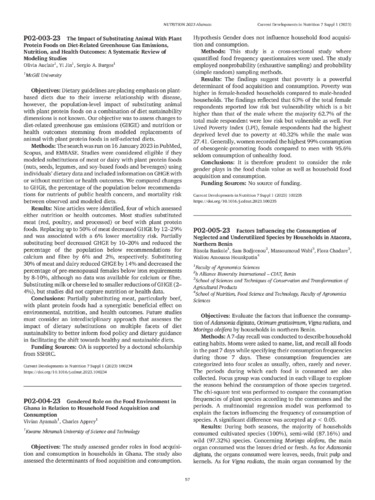P02-005-23 Factors Influencing the Consumption of Neglected and Underutilized Species by Households in Atacora, Northern Benin
Objectives: Evaluate the factors that influence the consump tion of Adansonia digitata, Ocimum gratissimum, Vigna radiata, and Moringa oleifera by households in northern Benin.
Methods: A 7-day recall was conducted to describe household eating habits. Moms were asked to name, list, and recall all foods in the past 7 days while specifying their consumption frequencies during those 7 days. These consumption frequencies are categorized into four scales as usually, often, rarely and never.
The periods during which each food is consumed are also collected. Focus group was conducted in each village to explore the reasons behind the consumption of those species targeted.
The chi-square test was performed to compare the consumption frequencies of plant species according to the communes and the periods. A multinomial regression model was performed to explain the factors influencing the frequency of consumption of species. A significant difference was accepted at p < 0.05.
Results: During both seasons, the majority of households consumed cultivated species (100%), semi-wild (87.16%) and wild (97.32%) species. Concerning Moringa oleifera, the main organ consumed was the leaves dried or fresh. As for Adansonia digitata, the organs consumed were leaves, seeds, fruit pulp and kernels. As for Vigna radiata, the main organ consumed by the households was the seeds which could be boiled or consumed as toubani. Regarding Occimum gratissimum, only leaves were used and consumed fresh in soup. Then, mother’s age and ethnicity influence the frequency of consumption of baobab pulp and fresh baobab leaf sauce P < 0.05. The season has an effect on consumption frequency of basilic of fresh leaves soup as well P < 0.05. Some factors such as knowledge of use, easy physical accessibility, knowledge have positive influence on increase consumption of the species. However, the economic value, the low availability and taboos can explain the decrease of some foods as toubani of mung bean.
Conclusions: The majority of households consumed culti vated, semi-wild and wild species, and several organs are consumed by the population, especially the leaves and seeds.
Several socio-demographic, financial and knowledge-related factors can explain the consumption or not of the different selected species.
Funding Sources: Deutsche Gesellschaft für Internationale Zusammenarbeit (GIZ)

